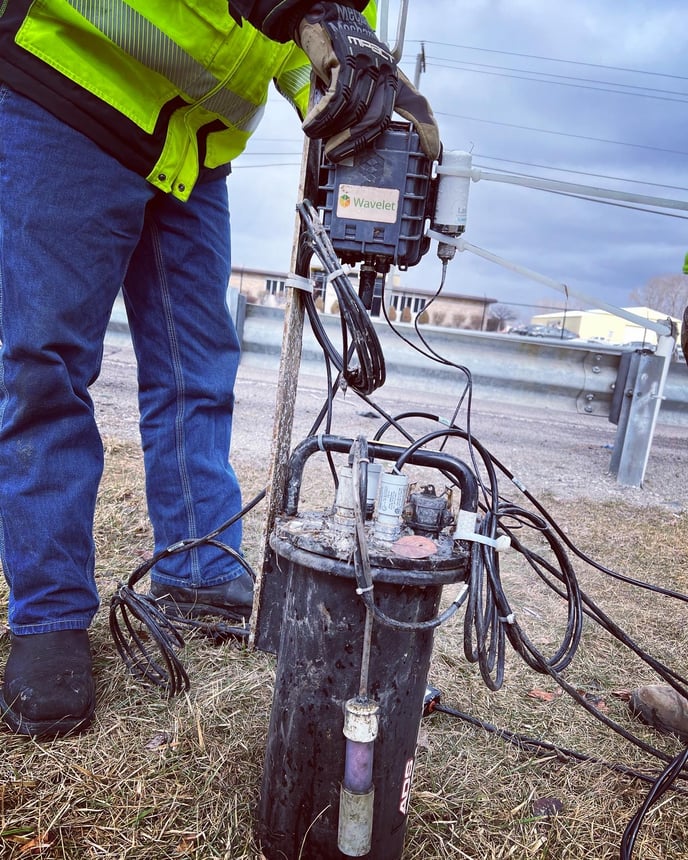How to use the proper cellular antenna, ensure it's well positioned, and get good signal quality. Nailing the details is essential for optimal wireless connectivity & battery life of the Wavelet datalogger.
Always use high-quality external antennae. Not all antennae are alike, and external appearance has nothing to do with the actual RF performance of the antenna.
Contents
Photo: An example of a failed installation.
Overview
- Availability: Cellular communication is only available in some places. It depends on the infrastructure deployed by the cellular provider in a specific area.
- Predictability: Cellular signal strength is hard to predict. It is common to have a good signal in a specific spot and a bad one only a few feet away.
- Equipment dependency - The antenna design and specific installation conditions dramatically affect the signal strength.
- Underground performance: In most cases, if you have a fair or better above-ground signal, you can get an adequate signal underground. Cellular frequencies have a reasonably good ground penetration capability. Metallic objects (such as the manhole cover) or high water content in the ground will reduce the penetration.
In Ayyeka, most of our installations are underground and in the most challenging environments. So we have developed the understanding, know-how, and expertise in getting cellular signals, even in challenging site conditions.
Here are some of them:
- To start with, we equip the Wavelet with a multi-carrier SIM card. So we can work with more than one cellular provider and pick the best signal for every site.
- We developed the antenna installation guidelines to instruct the install crews on how best to position and install the antenna (not as close as possible to the cover as most of them think!).
- We extensively studied different antennas together with Radio-Frequency experts. We chose the best antennas for field asset monitoring.
- In the rare cases that you cannot get a good signal underground in a specific site, we recommend that our customers install a different antenna (above ground). There will be a higher cost associated with such antennas.
- We allow customers to bring their antennae as well. If they prefer to, some have particular preferences.
The Wavelet device uses cellular communication to communicate data from the field to the FAI platform. Depending on the specific Wavelet part number, the device uses 4G/3G/2G cellular network technologies. It is important to understand that lack of cellular coverage will prevent the Wavelet from communicating data. A good antenna is critical to the optimal performance of the Wavelet.
A good signal on your smartphone only sometimes guarantees a good signal with the Wavelet!
Pay special attention to the antennae and the installed device's signal quality to achieve optimal results. Good signal strength will result in more reliable connectivity and longer battery life for devices in the field.
Antenna types
All Wavelet models require an external antenna. The Wavelet 4 V2 model has an additional internal antenna for use as a backup antenna.
The internal antenna in the Wavelet 4 V2 model is used as a backup antenna only. Make sure always to install the devices with an appropriate external antenna.
The external antenna has various shapes and mounting options (magnetic, dome, patch, and in-road). Make sure you use the proper antenna that fits the site conditions. Also, notice that some antennas require a ground plane for optimal performance, so they must be installed on a metallic plate, which comes with the antenna.
Using your own antenna
If you intend to use your own antenna, make sure that the antenna uses an SMA male connector and that the connector is stainless steel.
Your antenna should support all of the following frequencies (note the Model Number suffix of your Wavelet device, for example: -US):
|
Technology |
-US, -SA |
-EU |
|
2G |
850, 900, 1800, 1900 MHz |
900, 1800 MHz |
|
3G |
850, 1700, 1900 MHz |
900, 1800, 2100 MHz |
|
4G (LTE) |
700, 850, 1700, 1900 MHz |
800, 900, 1800, 2100, 2600 MHz |
Cellular antennas supporting 2G and 3G bands will typically support all bands for these cellular technologies. However, if using a locally sourced antenna, always ensure that the antenna works for 4G bands at the installation location. 4G frequency bands are not universal globally, so selecting the suitable antenna is pivotal.
Installation guidelines
- Ensure the antenna connector is secured tightly to the SMA female panel connector of the Wavelet.
- The magnetic mount and dome antenna supplied by Ayyeka must be properly mounted to the metal L-bracket supplied with these products. This bracket provides a ground plane for the antennas to ensure optimal performance.
- Wherever possible, the antenna should not be obstructed or enclosed by other metallic items, such as inside metal cabinets, underneath pipes, etc. The further and the higher away from obstructions the antennas can be placed, the better.
- If the antenna is installed underground, mount it at least 50 cm (20 in) beneath the lid/hatch and the street surface.
- The antenna must be mounted at least 5-10 cm (2-4 in) away from the wall.
- The antenna must be mounted at least 5 cm (2 in) away from the Wavelet.
- The cable length should be shorter than 3 m (9 ft) for typical installations. A long antenna cable results in gain loss, resulting in poorer signal quality. The shorter the cable, the better.
- Always use a high-quality cable with limited attenuation if using an antenna cable extension.
- The antenna cable must not be looped around the antenna.
- Do not wrap cables, zip ties, or other items around the antenna.
- If installing in a highly corrosive environment such as a sewer, apply technical grease to the antenna and sensor field attachable connectors after securing them to the panel connectors. Ayyeka recommends using Dow Corning Molykote 55 O-Ring Grease, although similar products can also be effective.
- Graphic of antenna installation:
How to check the antenna and signal.
Before leaving the site, make sure there’s a good signal and successful data transmission.
Use the AyyekaGo mobile app, and do the following steps:
- Select the Wavelet whose signal quality you want to check.
- Check that the CARRIER strength is 70% or higher. If the strength is less, re-position the antenna.
- Click TRANSMIT NOW or use the magnetic Wavelet Activator on the device to initiate a transmission. There will be a few minutes of delay before the data transmission begins. Repeating either method will not expedite data transmission.
In the FAI platform, create a technical stream of type Percentage (%). The antenna strength will be displayed in 0-100%.
If the Wavelet does not transmit, try moving the antenna to a different position.
If the Wavelet still does not transmit after multiple attempts at re-positioning the antenna, consider changing the antenna location, including an in-road antenna.

